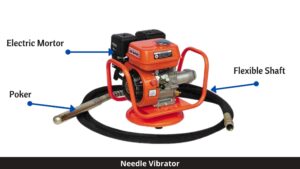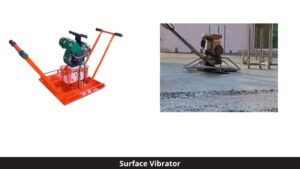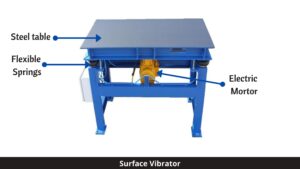The vibration of concrete and its importance:
Different types of concrete vibrators are used to perform the vibration of concrete. To learn more in detail we start learning about why we perform vibration for concrete
Concrete is the most complex mixture consists of Cement, Sand, and aggregate. Aside from technical properties, Do you know whats the prime objective for mixing these three materials in concrete?
The answer is to fill the voids. Yes!
Aggregates are irregular in size and have voids in it. To fill the voids, fine aggregate is mixed. The same goes for the Fine aggregate (Sand) voids made by them are filled with the cement.
The smallest particle cement also has air voids they filled with the water.
Even after filling the mixture with water, there is a still chance of air traps and water voids in it. The presence of voids in concrete leads to Segregation and bleeding.
It has proven that the voids occupy about 5% to 8% of total volume in freshly mixed concrete.
The principal objective for performing the vibration in concrete is to eliminate those voids and make the concrete free from air and water traps. This process is named Consolidation.
Consolidation increases the density of concrete, vibrating the concrete does that. Adding less water than required lowers the risk of the volume of water voids compromising the workability of concrete. Vibration is the only way to work out without compromising the workability of concrete.
Contents
What is Vibrating Concrete? What does it do?
A Concrete vibrator is a tool or a machine that vibrates the concrete to expel the water and air traps in it.
Vibration helps in minimizing the internal friction by randomizing the concrete mixture. Vibration rearranges the cement and aggregate particles in concrete; this helps concrete in achieving the close configuration.
Close configuration expels the water voids and air pockets in the mixture and results in a dense and compact mass of concrete.
Concrete Vibration Methods:
Compaction of concrete or Vibration of concrete can be performed in five different methods they are
- Vibrating the concrete internally by inserting an internal vibrator into concrete mass.
- Vibrating the concrete while fixing the shuttering using Shutter formwork vibrators
- By Vibrating the entire mass of concrete using a vibrating table
- Vibrating the concrete externally on the surface using surface vibrators
- Vibrating the concrete using rebar shakers.
Internal vibration or compaction of concrete is performed by using immersion vibrators.
1. Immersion Vibrators:
Immersion Concrete vibrator is also called as Internal vibrator or needle vibrator. Vibrator consists of a poker a steel tube with an eccentric element in it, which is closed and rounded at one end. Eccentric elements inside the steel tube cause the vibrations in the concrete.
Moreover, the other end of Poker is connected to the power source (electric motor or diesel engine) through a flexible tube.

A flexible tube is available in different diameters ranging between 20mm to 100mm, and the length varies from 25cm to 90cm.
The selection of the diameter of the flexible tube chosen by considering the spacing between the reinforcing bars. At places where there is less space between the reinforcement (congested reinforcement), the needle may not go into the concrete pour. In this scenario, the needle is replaced with blades of the same length; the vibration in blade promotes the compaction of concrete in congested reinforcement.
The radius of action of immersion vibrator is 1.0m (1000mm). Concrete shall never be poured in layers thicker than 600mm or 10times the dia of Poker.
Once the concrete is poured, the immersion vibrator is inserted vertically into the concrete pour. Immersion vibrator can vibrate at a frequency of 15000rpm. It is recommended to keep the vibration between 3000rpm to 6000rpm with an acceleration of 4g to 10g.
The period of vibration required may be of the order of 30 seconds to 2 minutes. Once the vibration is performed, the vibrator is slowly withdrawn (3inches/sec) from the concrete mass; vibrators allow trapped air in concrete to float on the concrete’s surface, which ultimately compacts the concrete.
- The radius of Action of Immersion vibrator is 1.0m
- The operating frequency of Immersion vibrator is up to 15000rpm
- The max compaction time period required to vibrate the concrete using immersion type vibrator is 2mins.
2. Formwork vibrators:
Formwork vibrators are also called as Shuttering vibrators where the vibrators are clamped externally at specific points on formwork. The position of these points decided on the thickness and depth of the concrete inside the formwork.

As the vibrators are clamped externally on formwork, the inside concrete mass has a direct effect on it.
The compaction time or vibrating time in the formwork vibrator is 1mins to 2mins. The formwork vibrator can vibrate at a speed of 9000 cycles per min. The vibration for the concrete is given through formwork. So, the formwork should be rigid and watertight to withstand the activity of vibration.
Read: What is formwork?
This type of vibrator consumes more power than any other type of vibrator. Formwork vibration is generally adopted in columns where there is an interruption of lateral ties inside the concrete.
- The compaction time or vibrating time in the formwork vibrator is 1mins to 2mins.
- The operating frequency of the Formwork vibrator is 9000rpm.
3. Surface vibrators:
Surface vibrators are also called as an External Vibrators. Once the concrete mix is poured on the surface, vibrators are placed on it. This type of vibrator is beneficial to the slabs having depth up to 10inches or 250mm. Surface vibrators are used for the precast slabs and retaining walls.

However, this type of vibrator is not recommended for the structures whose depth is more than 10inches or 250mm as the lower layer of concrete will not receive adequate vibration.
The operating frequency of surface vibrators is about 3000 to 4000 rpm at an acceleration of 4g to 9g.
Surface vibrators commonly used for patchwork in pavement slabs. Dry mixes which have lower water to cement ratio is most effectively compacted with the surface type vibrators.
4. Reinforcement bars Shaker:
Rebar shaker is the cheapest method among all other concrete vibrating techniques. This vibrator is similar to an internal vibrator, where the rebar itself acts as a vibrating tip.
Shaker can easily fasten to rebar of any size. The device (shaker) slipped at the top of the projected rebar, and the reinforcement bars itself transmits the vibration into the concrete. Rebar shaker compacts the concrete in 5secs to 7secs. The operation time is very less when compared with the other vibrating methods.
The only disadvantage with this type of vibrating is sometimes the lateral ties may disorient and loosen due to the excessive vibration of rebars.

5. Vibratory table:
The vibratory table is also called a Concrete Vibration table. This type of method generally chosen for harsh and stiff concrete mixes, and it is a laboratory method.
The rigidly built steel vibrating table mounted on flexible springs. These springs are further connected to Electric mortar, which drives the vibrating table to vibrate the concrete through springs.
The concrete vibrating table has a frequency of 4000rpm at an acceleration of 4g to 7g. Precast industries to make Precast elements use a vibratory table to vibrate the concrete.

FAQs on Vibration of concrete:
Also Read:
Important properties of concrete
Compaction factor test of concrete to test the Vibration of concrete
Curing of concrete and Curing methods
Segregation and bleeding in concrete
